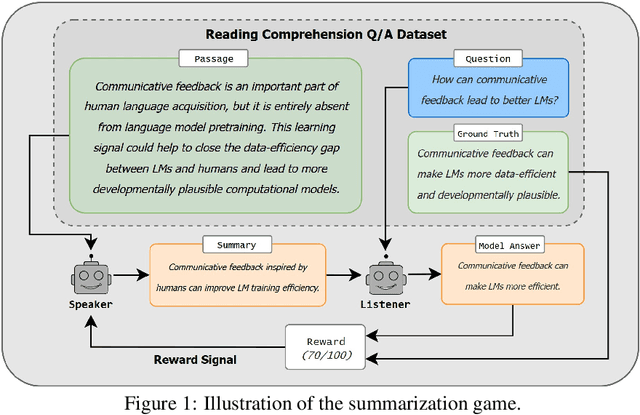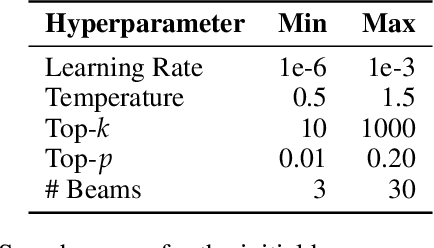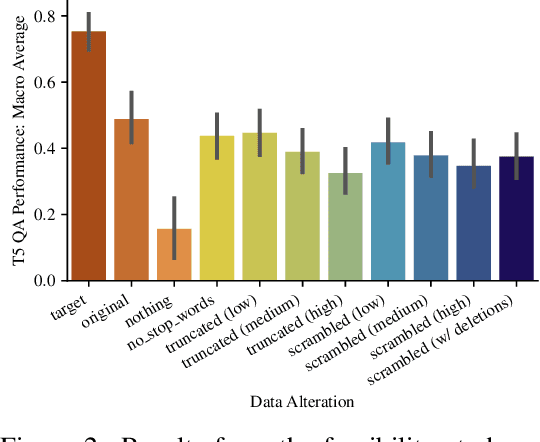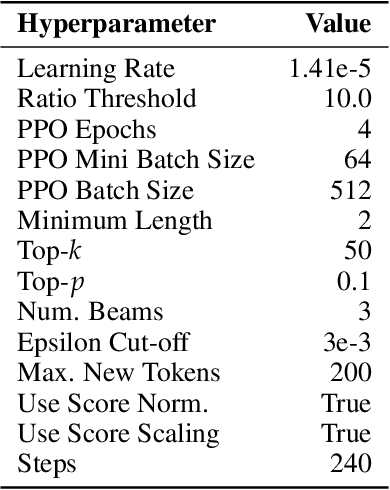Alex Warstadt
SED
The Harmonic Structure of Information Contours
Jun 04, 2025Abstract:The uniform information density (UID) hypothesis proposes that speakers aim to distribute information evenly throughout a text, balancing production effort and listener comprehension difficulty. However, language typically does not maintain a strictly uniform information rate; instead, it fluctuates around a global average. These fluctuations are often explained by factors such as syntactic constraints, stylistic choices, or audience design. In this work, we explore an alternative perspective: that these fluctuations may be influenced by an implicit linguistic pressure towards periodicity, where the information rate oscillates at regular intervals, potentially across multiple frequencies simultaneously. We apply harmonic regression and introduce a novel extension called time scaling to detect and test for such periodicity in information contours. Analyzing texts in English, Spanish, German, Dutch, Basque, and Brazilian Portuguese, we find consistent evidence of periodic patterns in information rate. Many dominant frequencies align with discourse structure, suggesting these oscillations reflect meaningful linguistic organization. Beyond highlighting the connection between information rate and discourse structure, our approach offers a general framework for uncovering structural pressures at various levels of linguistic granularity.
Using Information Theory to Characterize Prosodic Typology: The Case of Tone, Pitch-Accent and Stress-Accent
May 12, 2025Abstract:This paper argues that the relationship between lexical identity and prosody -- one well-studied parameter of linguistic variation -- can be characterized using information theory. We predict that languages that use prosody to make lexical distinctions should exhibit a higher mutual information between word identity and prosody, compared to languages that don't. We test this hypothesis in the domain of pitch, which is used to make lexical distinctions in tonal languages, like Cantonese. We use a dataset of speakers reading sentences aloud in ten languages across five language families to estimate the mutual information between the text and their pitch curves. We find that, across languages, pitch curves display similar amounts of entropy. However, these curves are easier to predict given their associated text in the tonal languages, compared to pitch- and stress-accent languages, and thus the mutual information is higher in these languages, supporting our hypothesis. Our results support perspectives that view linguistic typology as gradient, rather than categorical.
Towards Developmentally Plausible Rewards: Communicative Success as a Learning Signal for Interactive Language Models
May 09, 2025



Abstract:We propose a method for training language models in an interactive setting inspired by child language acquisition. In our setting, a speaker attempts to communicate some information to a listener in a single-turn dialogue and receives a reward if communicative success is achieved. Unlike earlier related work using image--caption data for interactive reference games, we operationalize communicative success in a more abstract language-only question--answering setting. First, we present a feasibility study demonstrating that our reward provides an indirect signal about grammaticality. Second, we conduct experiments using reinforcement learning to fine-tune language models. We observe that cognitively plausible constraints on the communication channel lead to interpretable changes in speaker behavior. However, we do not yet see improvements on linguistic evaluations from our training regime. We outline potential modifications to the task design and training configuration that could better position future work to use our methodology to observe the benefits of interaction on language learning in computational cognitive models.
Findings of the BabyLM Challenge: Sample-Efficient Pretraining on Developmentally Plausible Corpora
Apr 10, 2025



Abstract:Children can acquire language from less than 100 million words of input. Large language models are far less data-efficient: they typically require 3 or 4 orders of magnitude more data and still do not perform as well as humans on many evaluations. These intensive resource demands limit the ability of researchers to train new models and use existing models as developmentally plausible cognitive models. The BabyLM Challenge is a communal effort in which participants compete to optimize language model training on a fixed data budget. Submissions are compared on various evaluation tasks targeting grammatical ability, downstream task performance, and generalization. Participants can submit to up to three tracks with progressively looser data restrictions. From over 30 submissions, we extract concrete recommendations on how best to train data-efficient language models, and on where future efforts should (and perhaps should not) focus. The winning submissions using the LTG-BERT architecture (Samuel et al., 2023) outperformed models trained on trillions of words. Other submissions achieved strong results through training on shorter input sequences or training a student model on a pretrained teacher. Curriculum learning attempts, which accounted for a large number of submissions, were largely unsuccessful, though some showed modest improvements.
* Published in Proceedings of BabyLM. Please cite the published version on ACL anthology: http://aclanthology.org/2023.conll-babylm.1/
The time scale of redundancy between prosody and linguistic context
Mar 14, 2025Abstract:In spoken language, speakers transmit information not only using words, but also via a rich array of non-verbal signals, which include prosody -- the auditory features of speech. However, previous studies have shown that prosodic features exhibit significant redundancy with both past and future words. Here, we examine the time scale of this relationship: How many words in the past (or future) contribute to predicting prosody? We find that this scale differs for past and future words. Prosody's redundancy with past words extends across approximately 3-8 words, whereas redundancy with future words is limited to just 1-2 words. These findings indicate that the prosody-future relationship reflects local word dependencies or short-scale processes such as next word prediction, while the prosody-past relationship unfolds over a longer time scale. The latter suggests that prosody serves to emphasize earlier information that may be challenging for listeners to process given limited cognitive resources in real-time communication. Our results highlight the role of prosody in shaping efficient communication.
Can Language Models Learn Typologically Implausible Languages?
Feb 17, 2025Abstract:Grammatical features across human languages show intriguing correlations often attributed to learning biases in humans. However, empirical evidence has been limited to experiments with highly simplified artificial languages, and whether these correlations arise from domain-general or language-specific biases remains a matter of debate. Language models (LMs) provide an opportunity to study artificial language learning at a large scale and with a high degree of naturalism. In this paper, we begin with an in-depth discussion of how LMs allow us to better determine the role of domain-general learning biases in language universals. We then assess learnability differences for LMs resulting from typologically plausible and implausible languages closely following the word-order universals identified by linguistic typologists. We conduct a symmetrical cross-lingual study training and testing LMs on an array of highly naturalistic but counterfactual versions of the English (head-initial) and Japanese (head-final) languages. Compared to similar work, our datasets are more naturalistic and fall closer to the boundary of plausibility. Our experiments show that these LMs are often slower to learn these subtly implausible languages, while ultimately achieving similar performance on some metrics regardless of typological plausibility. These findings lend credence to the conclusion that LMs do show some typologically-aligned learning preferences, and that the typological patterns may result from, at least to some degree, domain-general learning biases.
A Distributional Perspective on Word Learning in Neural Language Models
Feb 09, 2025Abstract:Language models (LMs) are increasingly being studied as models of human language learners. Due to the nascency of the field, it is not well-established whether LMs exhibit similar learning dynamics to humans, and there are few direct comparisons between learning trajectories in humans and models. Word learning trajectories for children are relatively well-documented, and recent work has tried to extend these investigations to language models. However, there are no widely agreed-upon metrics for word learning in language models. We take a distributional approach to this problem, defining lexical knowledge in terms of properties of the learned distribution for a target word. We argue that distributional signatures studied in prior work fail to capture key distributional information. Thus, we propose an array of signatures that improve on earlier approaches by capturing knowledge of both where the target word can and cannot occur as well as gradient preferences about the word's appropriateness. We obtain learning trajectories for a selection of small language models we train from scratch, study the relationship between different distributional signatures, compare how well they align with human word learning trajectories and interpretable lexical features, and address basic methodological questions about estimating these distributional signatures. Our metrics largely capture complementary information, suggesting that it is important not to rely on a single metric. However, across all metrics, language models' learning trajectories fail to correlate with those of children.
Findings of the Second BabyLM Challenge: Sample-Efficient Pretraining on Developmentally Plausible Corpora
Dec 06, 2024Abstract:The BabyLM Challenge is a community effort to close the data-efficiency gap between human and computational language learners. Participants compete to optimize language model training on a fixed language data budget of 100 million words or less. This year, we released improved text corpora, as well as a vision-and-language corpus to facilitate research into cognitively plausible vision language models. Submissions were compared on evaluation tasks targeting grammatical ability, (visual) question answering, pragmatic abilities, and grounding, among other abilities. Participants could submit to a 10M-word text-only track, a 100M-word text-only track, and/or a 100M-word and image multimodal track. From 31 submissions employing diverse methods, a hybrid causal-masked language model architecture outperformed other approaches. No submissions outperformed the baselines in the multimodal track. In follow-up analyses, we found a strong relationship between training FLOPs and average performance across tasks, and that the best-performing submissions proposed changes to the training data, training objective, and model architecture. This year's BabyLM Challenge shows that there is still significant room for innovation in this setting, in particular for image-text modeling, but community-driven research can yield actionable insights about effective strategies for small-scale language modeling.
Surprise! Uniform Information Density Isn't the Whole Story: Predicting Surprisal Contours in Long-form Discourse
Oct 21, 2024



Abstract:The Uniform Information Density (UID) hypothesis posits that speakers tend to distribute information evenly across linguistic units to achieve efficient communication. Of course, information rate in texts and discourses is not perfectly uniform. While these fluctuations can be viewed as theoretically uninteresting noise on top of a uniform target, another explanation is that UID is not the only functional pressure regulating information content in a language. Speakers may also seek to maintain interest, adhere to writing conventions, and build compelling arguments. In this paper, we propose one such functional pressure; namely that speakers modulate information rate based on location within a hierarchically-structured model of discourse. We term this the Structured Context Hypothesis and test it by predicting the surprisal contours of naturally occurring discourses extracted from large language models using predictors derived from discourse structure. We find that hierarchical predictors are significant predictors of a discourse's information contour and that deeply nested hierarchical predictors are more predictive than shallow ones. This work takes an initial step beyond UID to propose testable hypotheses for why the information rate fluctuates in predictable ways
Do Language Models Have a Critical Period for Language Acquisition?
Jul 27, 2024Abstract:Humans appear to have a critical period (CP) for language acquisition: Second language (L2) acquisition becomes harder after early childhood, and ceasing exposure to a first language (L1) after this period (but not before) typically does not lead to substantial loss of L1 proficiency. It is unknown whether these CP effects result from innately determined brain maturation or as a stabilization of neural connections naturally induced by experience. In this study, we use language models (LMs) to test the extent to which these phenomena are peculiar to humans, or shared by a broader class of language learners. We vary the age of exposure by training LMs on language pairs in various experimental conditions, and find that LMs, which lack any direct analog to innate maturational stages, do not show CP effects when trained sequentially on L1 and L2. Our results contradict the claim that CP effects are an inevitable result of learning in statistical learners, and they are consistent with an innate mechanism for CP effects. We show that we can reverse-engineer the CP by introducing a regularizer partway through training to simulate a maturational decrease in plasticity. All in all, our results suggest that L1 learning on its own may not be enough to induce a CP, and additional engineering is necessary to make language models more cognitively plausible.
 Add to Chrome
Add to Chrome Add to Firefox
Add to Firefox Add to Edge
Add to Edge